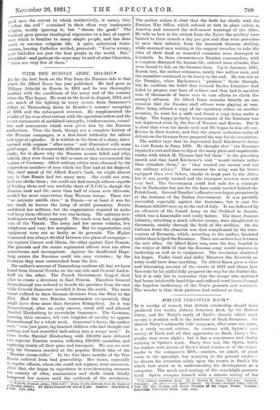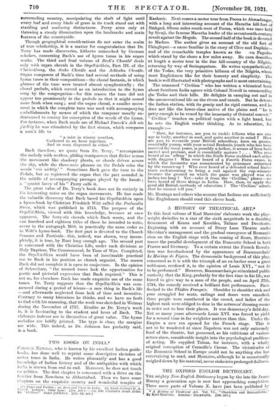JOHANN SEBASTIAN BACH.*
IT is worthy of remark that British scholarship should have produced two works, Johann Sebastian Bach, by Sir Hubert Parry, and Dr. Terry's study of Bach's chorale, which must occupy a position well in the forefront of Bach literature. Sir Hubert Parry's admirable Life' reappcs.rs, after some ten years, in a tardy second edition. In contrast with Spitta's vast survey of Bach and all that appertains to Bach, Parry's bio- graphy may seem slight ; but it has a conciseness and clarity wanting in Spitta's work. Parry does not, like Spitta, laden his readers with details of Bach's third cousins or of the water- marks in the composer's MSS.—matters, we admit, of great value to the specialist, but wearying to the general reader— he directs his attention solely upon the events in Bach's life which best assist us in understanding his development as a composer. The much used analogy of the searchlight presents itself. Spitta occupies himself with a minute survey of the • (1) Johann Sebastian Bach. By C. Hubert H. Parry, Mus.Doe. London : Putnam's. [Os. net.]—(2) Bach's Chorale. By Charles Sanford Terry, Litt.D. Part Hi The Hymns and Hymn Melodies of the Organ Works. London Cambridge University Press. [305. net.]
surrounding country, manipulating the shaft of light until every leaf and every blade of grass in its track stand out with startling and confusing distinctness. Parry aims only at throwing a steady illumination upon the landmarks and main features of the countryside.
Though geographical considerations do not enter the realm of true scholarship, it is a matter for congratulation that Dr. Terry has made discoveries, hitherto untouched by German scholars, concerning Bach's use of hymn tunes in his organ works. The third and final volume of Bach's Chorale deals only with organ chorale in the Orgelbachlein, Part III. of the Clarierii5ung, the Sechs Chorale and the Achtzehn Chorale. Organ composers of Bach's time had several methods of using hymn tunes in their compositions—the choral fantasia, in which phrases of the tune were treated almost symphonically ; the choral prelude, which served as an introduction to the hymn sung by the congregation—for this reason the tune did not appear too prominently in the prelude so that it might sound more fresh when sung ; and the organ choral, a smaller move- ment in which the complete tune was used with accompanying embellishments by means of which the composer usually en- deavoured to convey his conception of the words of the hymn. For instance, when Bach made use of Michael Franck's Ach wie '1W:hag he was stimulated by the first stanza, which compares a man's life to " a mist in wintry weather, Gathered in an hour together, And as soon dispersed in ether."
Bach therefore, we quote from Dr. Terry, " accompanies the melody with restless, gliding semiquavers that flicker across the movement like shadowy ghosts, or clouds driven across the sky, while the three-note phrases on the Pedals echo the words ` tvie nichtig.' " Sometimes Bach gave the tune to the Pedals, but so registered the organ that the part sounded in the middle of accompanying passages played by the hands ; a " quaint fancy of his " Parry calls it..
The great value of Dr. Terry's book does not lie entirely in Lis interesting notes on the organ movements. He has made the valuable discovery that Bach based his Orgelbiichlein upon a hymn-book by Christian Friedrich Witt called the P8almodia Sacra, which was published in 1715. The purpose of the Orgelbii:Alein, viewed with this knowledge, becomes at once apparent. The forty-six chorale which Bach wrote, and the one hundred and eighteen titles of those he intended to write, occur in the autograph MSS. in practically the same order as in Witt's hymn-book. The first part is devoted to the Church Seasons and Festivals—this, indeed, was shown, very incom- pletely, it is true, by Rust long enough ago. The second part is concerned with the Christian Life, under such divisions as Holy Baptism, The Commonweal, In Time of War. Completed, the Orgellitchlein would have been of inestimable practical use to Bach in his position as church organist. The reason Bach did not complete it is open to conjecture. In the opinion of Schweitzer, " the unused tunes lack the opportunities for poetic and pictorial expression that Bach required." This is not so, for elsewhere Bach has made exquisite use of the same tunes. Dr. Terry suggests that the Orgelbitchlein was com- menced during a period of leisure—a rare thing in Bach's life —and afterwards neglected from lack of time and incentive. Contrary to many historians he thinks, and we have no fault to find with his reasoning, that the work was sketched in Weimar during the November of 1717. Erudite as Dr. Terry's work is, it is fascinating to the student and lover of Bach. The elaborate indexes are in themselves of great value. The hymn melodies are boldly printed. The type is clear, the margins are wide. This indeed, as Dr. Johnson has probably said, is a book.











































 Previous page
Previous page